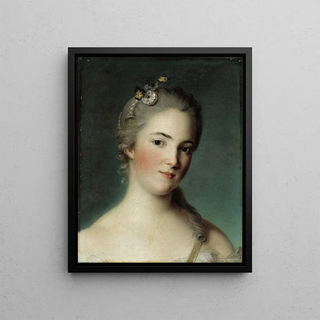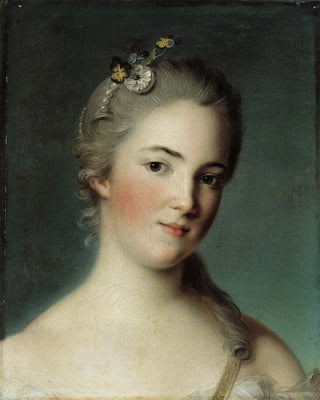Art print | Portrait of Marie-Geneviève Boudrey - Jean-Marc Nattier Source: Reproduction | Portrait de Marie-Geneviève Boudrey - Jean-Marc Nattier


View from behind

Frame (optional)
In the captivating world of 18th-century painting, the "Art print of Marie-Geneviève Boudrey" by Jean-Marc Nattier stands out for its elegance and finesse. This piece, emblematic of the rococo style, immerses us in an era where beauty and sophistication were celebrated through art. Marie-Geneviève Boudrey, a figure of high society, is depicted with a grace and delicacy that seem to transcend time. The gentle, penetrating gaze of the model, combined with the richness of the colors, evokes not only Boudrey's personality but also the spirit of a time when art and social life intertwined harmoniously.
Style and uniqueness of the work
Nattier's style is characterized by a subtle use of light and a pastel color palette, creating a soft and dreamy atmosphere. In this portrait, every detail is carefully crafted, from the sumptuous drapery of Marie-Geneviève's dress to the delicate accessories adorning her hairstyle. The artist manages to capture the very essence of his subject, bestowing upon her an aura of nobility and refinement. The composition, balanced and harmonious, highlights the natural beauty of the model while incorporating symbolic elements that reflect her social status. Boudrey's graceful posture, slightly turned to the right, invites the viewer to approach, to contemplate, and to appreciate the meticulousness of each brushstroke.
The artist and his influence
Jean-Marc Nattier, one of the most prominent portraitists of his time, knew how to establish himself through his exceptional talent and his ability to translate the personality of his models onto canvas. Trained in his father's workshop, also a painter, Nattier developed a style that is uniquely his own, blending classical influences with contemporary innovations. His fame reached great heights, leading him to paint members of royalty and aristocracy, notably at the court of Louis XV. Nattier not only left an indelible mark on the world of painting but also influenced many artists

Matte finish

View from behind

Frame (optional)
In the captivating world of 18th-century painting, the "Art print of Marie-Geneviève Boudrey" by Jean-Marc Nattier stands out for its elegance and finesse. This piece, emblematic of the rococo style, immerses us in an era where beauty and sophistication were celebrated through art. Marie-Geneviève Boudrey, a figure of high society, is depicted with a grace and delicacy that seem to transcend time. The gentle, penetrating gaze of the model, combined with the richness of the colors, evokes not only Boudrey's personality but also the spirit of a time when art and social life intertwined harmoniously.
Style and uniqueness of the work
Nattier's style is characterized by a subtle use of light and a pastel color palette, creating a soft and dreamy atmosphere. In this portrait, every detail is carefully crafted, from the sumptuous drapery of Marie-Geneviève's dress to the delicate accessories adorning her hairstyle. The artist manages to capture the very essence of his subject, bestowing upon her an aura of nobility and refinement. The composition, balanced and harmonious, highlights the natural beauty of the model while incorporating symbolic elements that reflect her social status. Boudrey's graceful posture, slightly turned to the right, invites the viewer to approach, to contemplate, and to appreciate the meticulousness of each brushstroke.
The artist and his influence
Jean-Marc Nattier, one of the most prominent portraitists of his time, knew how to establish himself through his exceptional talent and his ability to translate the personality of his models onto canvas. Trained in his father's workshop, also a painter, Nattier developed a style that is uniquely his own, blending classical influences with contemporary innovations. His fame reached great heights, leading him to paint members of royalty and aristocracy, notably at the court of Louis XV. Nattier not only left an indelible mark on the world of painting but also influenced many artists






